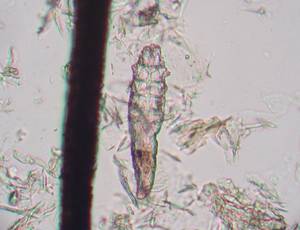What Is Canine Demodectic Mange?

Demodectic mange is a skin disease caused when a mite called Demodex, which usually is relatively harmless, proliferates and overpopulates the skin of its host animal.
These mites are found worldwide on many animals including dogs and cats, but usually in small numbers. Demodectic mange is caused in dogs by Demodex canis. While clinical demodicosis is frequent in dogs it is uncommon in cats, and human infection is rare.
Demodex canis mites
Adult Demodex mites are cigar-shaped, up to 0.3mm long and with eight blunt legs with claws at the end. The smaller legs reflect the fact that they don't walk about on the host nearly as much as other types of mites. The head features large protruding jaws feeding on skin debris. Its body is covered with a hard outer skeleton called the cuticle, which appears wrinkled.
Demodex mites spend their entire lives in hair follicles and occasionally sebaceous (oil) or sweat glands. The adult male and female mites mate and lay eggs in these glands. Demodex eggs are cigar-shaped, not oval like other mites. The eggs hatch into six-legged larvae, which molt sevral times into eight-legged nymph stages, before becoming adults. The lifecyc;e is usually complete within 18 and 24 days.
|
"Demodectic mange is found most frequently in dogs aged from three to 12 months."
|
Demodex mites are transmitted to pups from their mothers in the first few days after birth. Unlike worms, there is no transmission in the uterus and transmission between dogs other than mother to pup is rare. The disease is not considered to be contagious, unlike other forms of mange.
Many dogs harbor Demodex without any clinical problems. The mites burrow down deep into hair follicles. Dead mites can occasionally be found in the lymphatic system and blood stream, having been drained away from the base of the hair follicle by the body in order to remove them. Demodectic mange is found most frequently in dogs aged from three to 12 months.
There are two forms of the disease, localized and generalized.

The localized form is mainly seen in young dogs (between three to six months of age) and consists of one to several small areas of hair loss, usually around the eyes and muzzle, occasionally on the front legs or chest. Redness and scaling of the skin are present but these are not usually itchy. This form of the disease usually resolves spontaneously with no treatment being required. Less than 10 per cent of these cases progress to the generalized form.
Generalized demodectic mange
This is divided into two types, juvenile-onset and mature-onset. This type of disease tends to be more common in short-haired purebred dogs, such as Dobermans, Pugs, Sharpeis, Bulldogs and Boxers.
Generalized demodicosis starts as localized demodicosis and spreads. Areas of hair loss, scaling and inflammation, along with itching, are found on several areas of the body. Occasionally, this can present as demodicosis of the feet only, particularly in Old English Sheepdogs and Sharpeis. Lymph-node enlargement is common with this form of disease.
The mature-onset form of demodicosis is most often seen in dogs with an underlying immune deficiency or a severe infection or debilitating disease or cancer, and in dogs taking medications which suppress the immune system. One complication of the disease is deep bacterial infection of the skin which often fails to respond to treatment.
Juvenile-onset generalized demodicosis is considered to be the result of a genetic defect of the immune system. Because it is an hereditary disease, neither the mother nor father of affected litters should be used for breeding again. If a dog is less than one year old when the generalized form appears, it has a 30 to 50 per cent chance of self-curing.
�
�
|
References
|
| Payne, P.A., Dryden, M.W., Carter,G.R. External Parasitic Diseases of Dogs and
Cats. In: A Concise Guide to Infectious and Parasitic Diseases of Dogs and Cats International Veterinary
Information Service, Ithaca NY. www.ivis.org Tilley, L.P., Smith, F.W.K. The Five Minute Veterinary Consult Canine and Feline. Second Edition. Lippincott Williams & Wilkins, Baltimore, 2000. Demodectic Mange. www.maristvet.com |
Mitaban� is a registered trademark of Pfizer Inc.